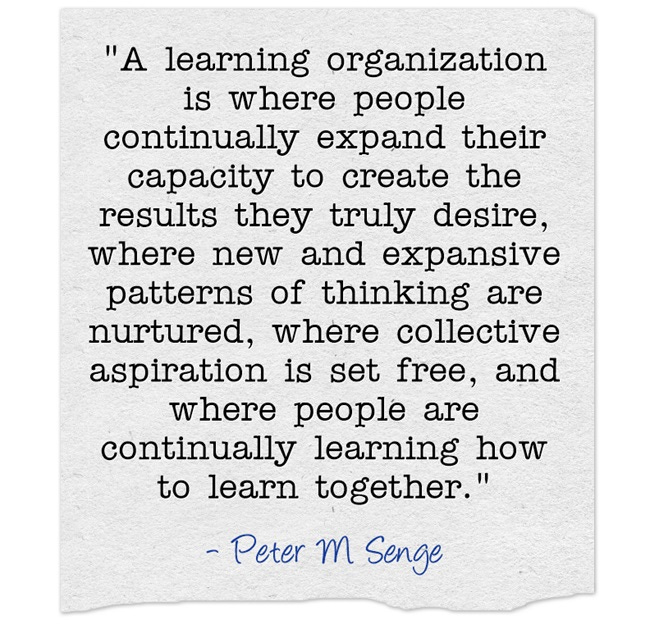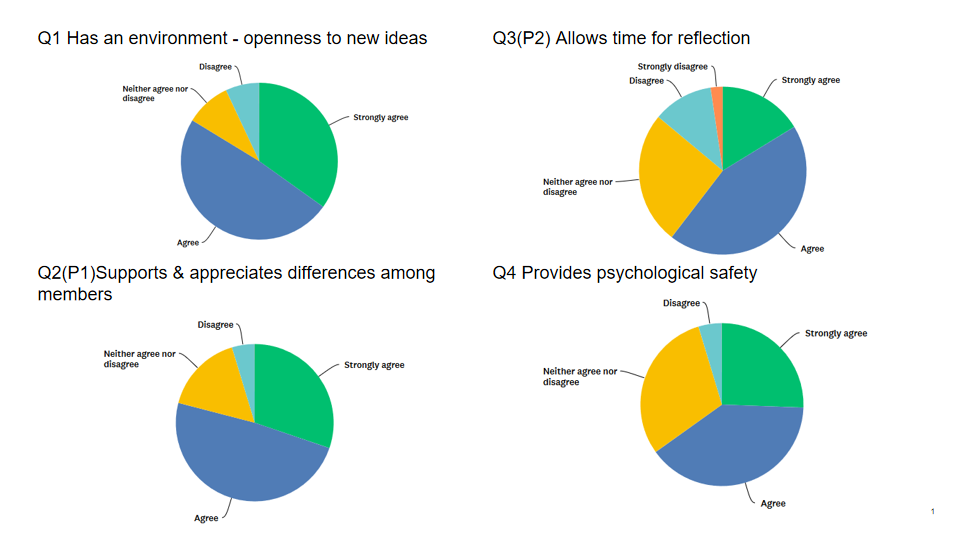
In today's world the role of "Learning" in education has acquired great value and has become the preferred mode as compared to "Teaching". This emphasis on learning and its growth has been due to the preponderance of digital information and easy access to it. Technology has been enabler in this respect. However, the change in organizations to adapt to the new situation has not been as quick because of traditional work styles or culture. One can argue, that on this front the slower rate of change is understandable because soft skills take longer time to acquire and adapt. But with it comes the problem of meeting the challenges of changes in technology and information overload which is happening here and now and in a VUCA* environment. The current pandemic situation has only exacerbated the situation by advancing a work culture and lifestyle which was possibly expected only in the future.
In context of the above situation, the concept of the "Learning Organization" as enunciated in the 1990s by Peter Senge and others has some relevance.
Can we imbibe some of the principles of a Learning Organization? How can we use the concept of a ’project’ here?
What is a Learning Organization?
So, what is a Learning Organization? Let's look at the definition. Some of the key words used in the definition organization, continually, capacity, thinking, organization, create, new, expansive, collective and learning explains the meaning. Peter Senge and many of his contemporaries spoke about it about 30 years ago and they are still valid and very much in use today.
Essentially, it's all about trying to understand how you do new things, which are of a new thought process, in a collective way in how we learn and grow continuously as an organization. And he particularly spoke about five disciplines that are required to be a learning organization. Personal mastery, mental models, team learning, shared vision, and systems thinking.
Let's look at them one by one briefly. Personal mastery is somewhat easier to understand. It implies lifelong learning. And the question of how you convert individual learning, or learning by ourselves, with our own initiative into organization learning. It's a process.
Mental models, talks about the generalizations assumptions as to how we perceive everything around us. And this is where possibly, we have to revisit and challenge our understanding. Let me give you an example here. Today, you find that because of the pandemic, because of the problem that we face, a lot of things are being done online. So oftentimes, it's felt that people expect that as soon as this problem is over, they will get back to the face-to-face mode of work. Will that happen? It may not be in exactly the same way, it will be possibly a hybrid, a little bit of both, because now we have tasted the benefits of online learning. And therefore, there'll be some using the online mode, and some face-to-face to face, both will co-exist. And this is the new mental model that we have to embrace, which means we'll have to look at new skills, and new ways of orienting ourselves.
When we consider team learning, this implies as do we learn as a team rather than an individual, how do we value the contribution of the synergy of the team rather than the team. And this has to be translated into a shared vision, which is a part of leadership. This is to ensure that whatever is required by the leaders of the organization are in fact understood and imbibed by everybody in the long run. And for all this to happen, we have to adopt a systems approach, which will help people become collaborative rather than permit the organization to work as silos.
Another aspect which has been emphasized is that as leaders, we have to look at ourselves as designers, teachers and stewards. This means as designers, we study and devise the process the organization can use, as teachers fostering learning within the organization and as stewards looking at service beyond our own self-interest for larger good of the organization.
So, these are some of the concepts that have come from the set of principles proposed by Peter Senge. These been there in a vogue for a long time. Sometimes, they are being applied consciously or they develop organically as part of the culture of the organization. Some examples include Adobe, Intel, GE, Google, BP, Corning and Honda. Toyota’s Management Principle #14 is Become a Learning Organization There are many other organizations, even smaller, where the concepts are applied but whose stories may not be documented in the public domain.
Is your organization a “learning organization”?
The HBR paper “Is Yours a Learning Organization” provides the parameters to evaluate our organization and use it for improvement.
I used the above parameters for a survey with small group of about 80 professionals.
From the responses of Disagree / Strongly Disagree we can see that organizations have still to work more on two areas, having an openness to new ideas and allowing time for reflection. In particular, the latter seems to be of significance considering modern day work ethic and competitive culture giving little time for thinking.
A poll was also conducted for two of the parameters with a group of about 800 people during my webinar with projectmanagement.com on Learning Organization and Projects.
Disagree / Strongly Disagree proportion has increased in the larger group for “supports and appreciates differences among members”. In case of “allows time for reflection” here the Disagree / Strongly Disagree is more or less same but Agree/ Strongly Agree has decreased.
These surveys give an idea of the issues that need to be addressed by organizations.
Learning Organization & Projects
Projects by its very nature, can be considered as a system for learning. For example, in school or university, we do a capstone project at the end of the course which is part of the learning. Every project is different, and this is accentuated by location, technology, culture, complexity, customers, etc. This is well understood by project managers who have the mindset and training to manage it. Interestingly, this can be used as a means of learning and when it is converted into knowledge then it can help in improving the maturity of processes and thereby the organization.
So, even if an organization is not project based and they are operational, there is a benefit by projectizing some of the work considering the benefits in learning.
Take-Aways
The concept of being a “Learning Organization” applies to all types of organizations. Those in the corporate sector, large or small, not-for-profit, professional organizations, educational institutions, clubs and groups.
Using the eight parameters mentioned in this article your organization can assess where they stand with regard to a being Learning Organization. This can be used as a basis for improvement.
Doing projects, working in project mode or projectizing your work can serve as a learning tool for people in your organization.
* Volatility Uncertainty Complexity Ambiguity











In 1990, around the time of Peter Senge’s book release, the Eicher Group I was working in resolved to become a Learning Organisation. Culturally, Eicher Group always placed the highest value on its Human Resources & encouraged new ideas from every member in the Organisation - particularly newly recruited Trainees. Very Large Group Decision Making Programs, involving over 200 members across every Level - from W1 Workmen to Supervisors to Managers to GM - & every Function, were organised across the Group to encourage myriad individual ideas & systemically converge to a common set of Goals. Even Recruitment processes underwent changes with New Training Programs for Eicher’s Recruiters to objectively assess & score Learning Ability of candidates.